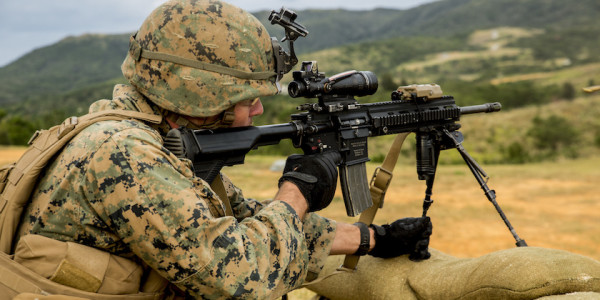

Last week, the U.S. Marine Corps released a Request for Information to manufacturers enquiring about their capacity to produce 11,000 more M27 Infantry Automatic Rifles. This stoked rumors that the Marine Corps is looking to replace its M4s with the M27, which were first sparked last November when 3rd Battalion, 5th Marines was equipped with the M27 instead of the M4 during pre-deployment exercises as an experiment.
The RFI for 11,000 M27s could indicate a possible push to replace the M249, which continues to be used by weapons platoons. However, I believe it is more likely that the Corps is simply looking to add more Infantry Automatic Rifles to its inventory. Currently, Marine infantry battalions typically have over 80 Infantry Automatic Rifles distributed at the fireteam level. Just 11,000 new rifles will not re-equip the riflemen of the Corps’ 32 infantry battalions, but it will enhance their firepower and perhaps pave the way for future orders.
Related: The Marines Are Experimenting With A New Infantry Rifle »
While the Marine Corps would no doubt love to replace its current service rifle with the M27, especially with the branch’s emphasis on marksmanship, the M27 is considerably more expensive. Each M27 costs in the region of $3,000, according to a November Military.com report. While this is cheaper than the M249, it is significantly more expensive than the M4, which costs approximately $750 per carbine. The Marines’ purchase of an additional 11,000 M27s, the Corps’ largest single order for the rifles so far, will probably cost in excess of $30 million. With the Marine Corps’ annual budget a fraction of other branches, it’s understandable that it is seeking to expand its capabilities with a battle-tested weapon system, rather than attempting to fully transition to the M27.

A U.S. Marine with Echo Company, 2nd Battalion, 5th Marine Regiment, 1st Marine Division, fires a M27 infantry automatic rifle at simulated enemies during an Integrated Training Exercise (ITX) at Marine Corps Air-Ground Combat Center Twentynine Palms, Calif., Aug. 18, 2016.U.S. Marine Corps photo
The demand for the M27’s improved accuracy over both the M249 and the M16A4 and M4 came from hard-learned lessons in Afghanistan. The M27 has a slightly longer range than the M4, and is able to hit targets out to 600 meters, while area fire is effective out to approximately 800 meters.
In 2015, the service announced a decision to move away from the long-serving M16 to the shorter M4, favored by the Army. At the same time, the Corps moved the M249 from fireteams to weapons platoons and introduced the M27. The M27 has the advantage of having fully automatic capability, something that the M4 and M16A4s, which have a three-round burst setting, do not have.
The M27 is based on Heckler & Koch’s gas-operated, piston-driven HK416. It has a free-floating 16.5-inch barrel to improve accuracy and cooling. The M27 feeds from standard 30-round or PMAG magazines; however, high-capacity magazines are a future option for suppressive fire. The IAR is issued with a Trijicon ACOG optic and a bipod for both precise accurate fire and suppressive fire. The Corps is also experimenting with suppressors for M27 and other small arms systems. In Afghanistan, the M27’s greater range, accuracy, and rate of fire were found to enhance Marine patrols, which had previously relied on M240 medium machine guns and designated marksmen to return longer range enemy fire effectively.
Only time will tell if the Marine Corps really intends to transition the M27 from a support weapon role to an infantry rifle. In the meantime, 11,000 more M27s will greatly enhance the Marine Infantry’s firepower.
